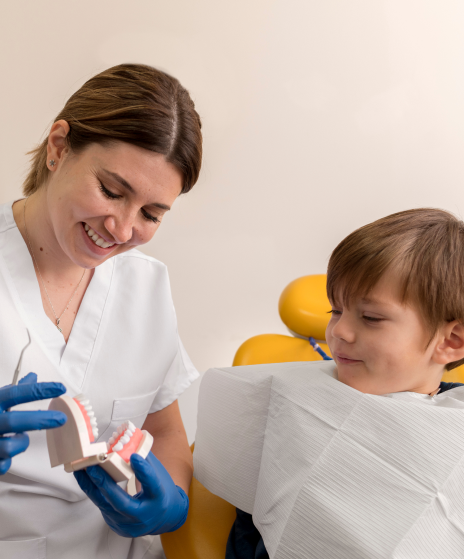BPA-Free Fillings
When your kids inevitably get cavities or experience nagging tooth decay, you want to be sure that the treatment doesn’t have lasting health repercussions. The fear stems from past material used in fillings. First, amalgam mercury fillings caused concern, and then bis-phenol A (BPA) fillings proved dangerous. Today, BPA-free fillings are common as a solution to tooth decay in children. Call Tiny Smiles
Pediatric Dentistry — in Woodbridge, NJ or in Manhattan on the Lower East Side and in Harlem — for the latest and safest dental procedures for your kids.

What Are BPA-Free Fillings?
BPA-free dental fillings have become the new standard, replacing composite fillings that contain bisphenol A (BPA). Dentists used amalgam mercury fillings for 100 years before scientists suspected the risk of mercury toxicity. BPA dental fillings emerged as a better, more cosmetically pleasing alternative. But further research showed that bisphenol A has detrimental health effects as well.
Bisphenol A is an endocrine disruptor found in some plastics and resins. It’s now known as a dangerous chemical with serious health implications. BPA traces have appeared in saliva samples. Since dental fillings are among the most common dental restorative treatments, dentists have switched to BPA-free fillings to safeguard their patients’ health.
The dentists at Tiny Smiles Pediatric Dentistry — in Harlem, on the Lower East Side or in Woodb-ridge, New Jersey — are leaders in the adoption of innovative dental technologies. These top-rated medical professionals regularly use BPA-free fillings to treat dental cavities in children.
The dental specialists at Tiny Smiles Pediatric Dentistry use the latest dental techniques. This dental practice relies on the latest equipment to address your children’s oral health. If your child complains of tooth pain, consult the best dentists in NJ and NYC. They deliver preventative treatments to prevent cavities that include:


How Are BPA-Free Fillings Used?
BPA-free fillings work like other normal composite white fillings. The only difference is that the fillings have no bisphenol A. During your child’s dental check-up, your pediatric dentist checks for cavities. While the specific procedure addresses the decay in your kid’s mouth, the general steps for using BPA-free fillings include:
Consultation. Before any dental procedure, the dentist listens to any concerns and asks questions to understand the history of the pain your child’s been feeling.
Dental examination. Your pediatric dentist uses probing instruments to assess your child’s oral health, looking for signs of tooth decay. The dentist focuses on the affected area, but evaluates the rest of the teeth too.
Dental x-rays. Sometimes, x-rays are required for your dentist to see the extent of the damage, especially if it’s beneath the gum line. Pediatric dentists may recommend dental x-rays once a year as a preventative measure.
Removal of decay. The dentist explains what to expect to relax your child, then numbs the gums around affected tooth with a topical anesthetic and uses modern, specialized tools to remove the decayed area of the tooth.
Cavity filling. After removing the damaged enamel, the dentist uses BPA-free composite material to fill the cavity.
Curing. Your dentist may use a special light to cure or harden the filling.
Polishing. After it sets and hardens, your pediatric dentist polishes the filling to ensure it looks like the other teeth and doesn’t impede the bite.
Aftercare. Your child may be advised to avoid eating or drinking until the numbness wears off. If your kid experiences further pain or tooth sensitivity after getting a BPA-free filling, call the dentist for a review.
The dentists at Tiny Smiles Pediatric Dentistry prepare the BPA-free fillings to suit your children’s unique needs. A top pediatric dentist — in Woodbridge, NJ, as well as in Harlem and the Lower East Side — develops a treatment based on the examination.
What Are the Dangers of Fillings with Bisphenol A?
Bisphenol A is an organic compound in some plastic and resin production. It can have adverse effects on your body if used in composite fillings. While dental composite resins don’t contain pure BPA, derivatives of BPA still pose risks, including:
- Developmental issues in children’s reproductive system and brain
- Increased risk of allergies
- Infertility
- Hormone disruptions
- Behavioral problems in kids
- Endocrine disorders
- Thyroid dysfunction
- Certain cancers
- High risk of hypertension and cardiovascular issues
The risk of adverse health effects from BPA makes BPA-free fillingsthe best alternative. The top pediatric dentists New York and New Jersey use these fillings to repair teeth with cavities, tooth decay or caries. This kid-friendly facility delivers exceptional dental solutions for your children.
Is My Child a Candidate for BPA-Free Fillings?
A regular dental checkup helps your pediatric dentist identify problems in your kid’s mouth early enough to recommend restorative procedures. Signs that your child’s a good candidate for BPA-free fillings include:
- A persistent toothache
- Experiencing throbbing pain when biting or chewing
- Sensitivity to hot or cold foods and drinks
- The need for a dental filling, but the desire to avoid the risks of bisphenol A
The board-certified dentists at this NJ and NYC pediatric dentistry practice review your suitability as a candidate for a dental filling. The state-of-the-art office offers a comfortable environment both for kids and their parents. They’re also experts in aesthetic treatments and orthodontic care. Contact a top pediatric dentist today and enjoy safe, painless dental procedures for your children.


